实例介绍
【实例简介】Pearson.Java.How.To.Program.late.objects.10th.Edition
【实例截图】
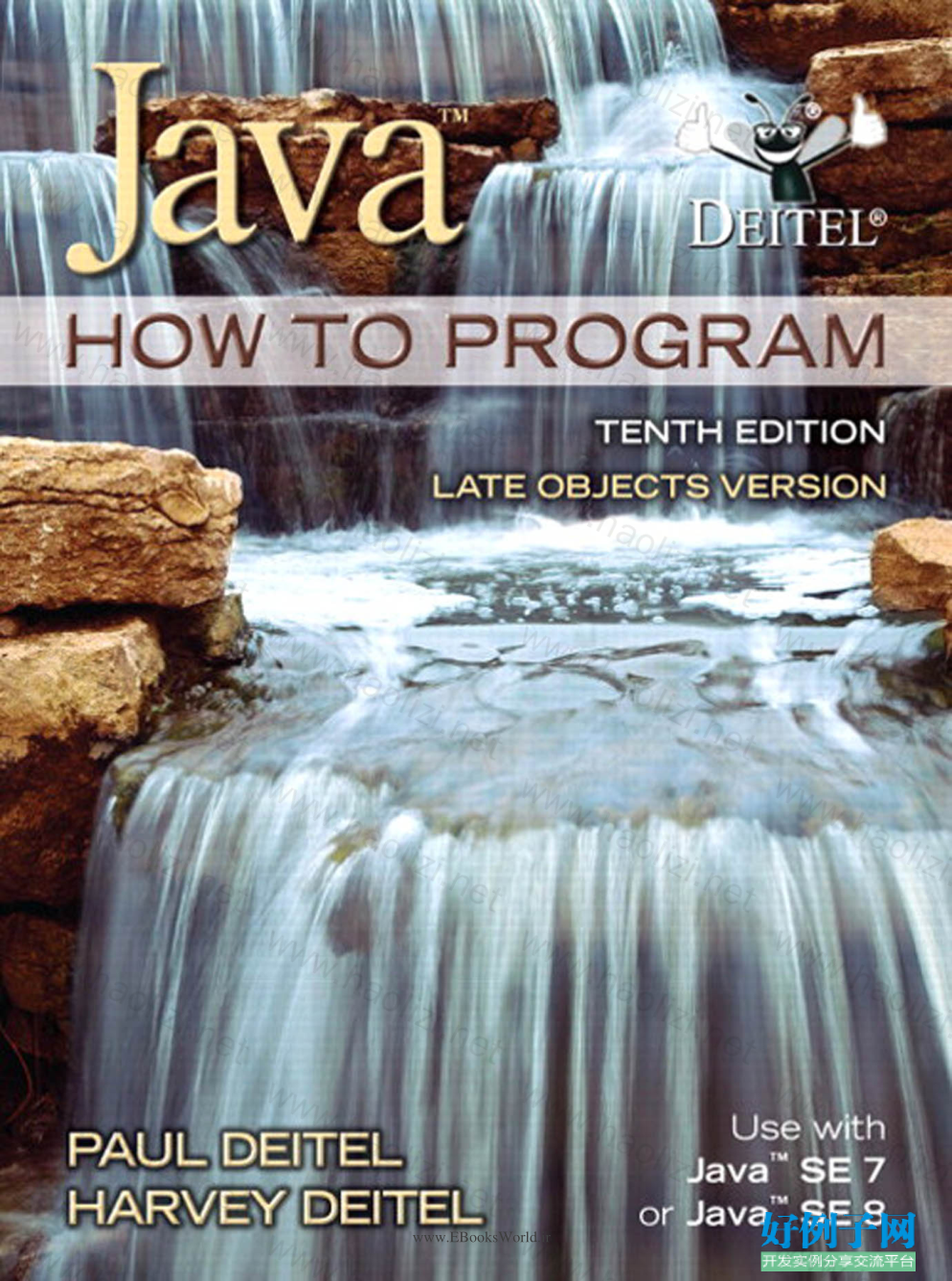
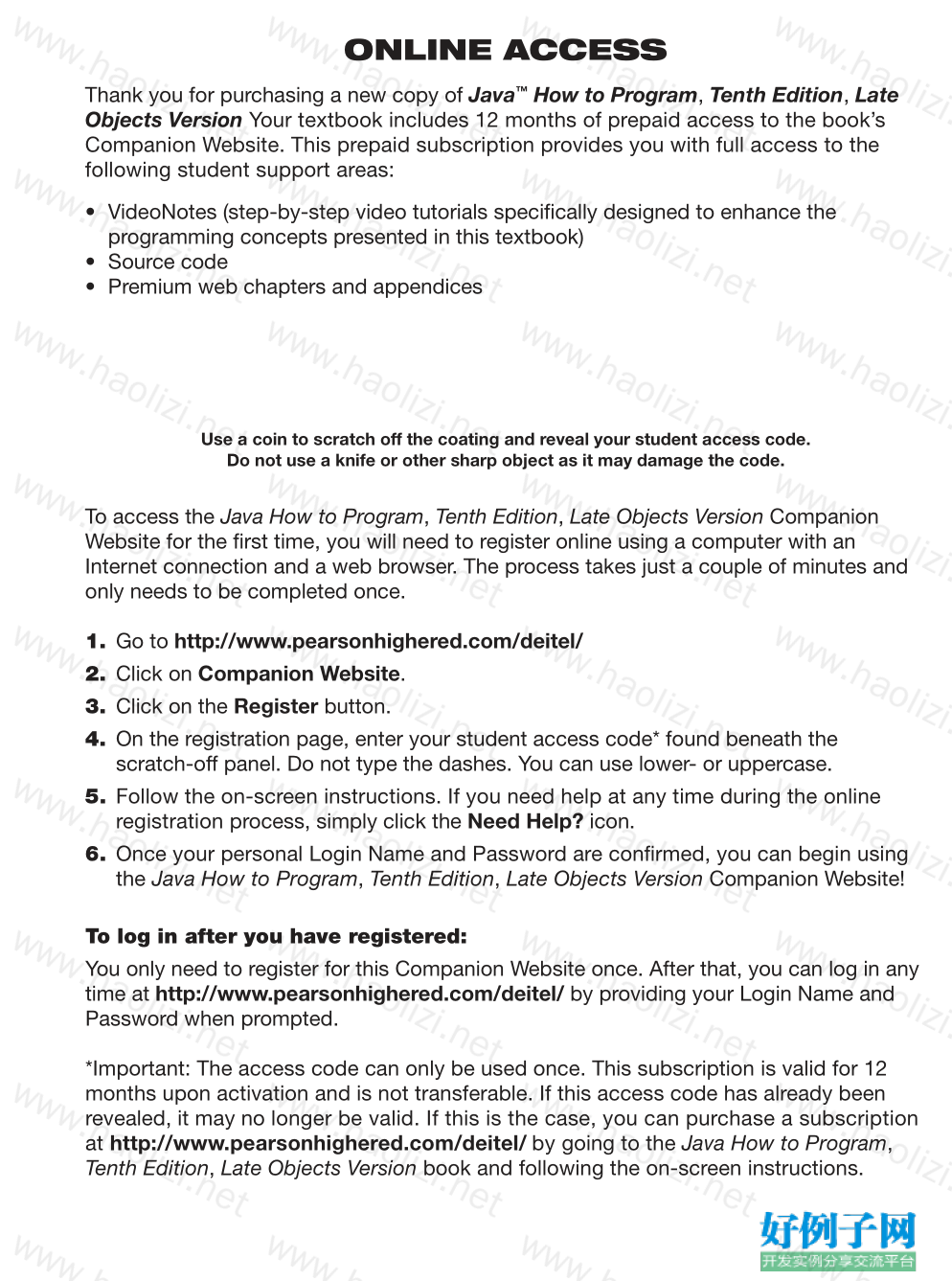
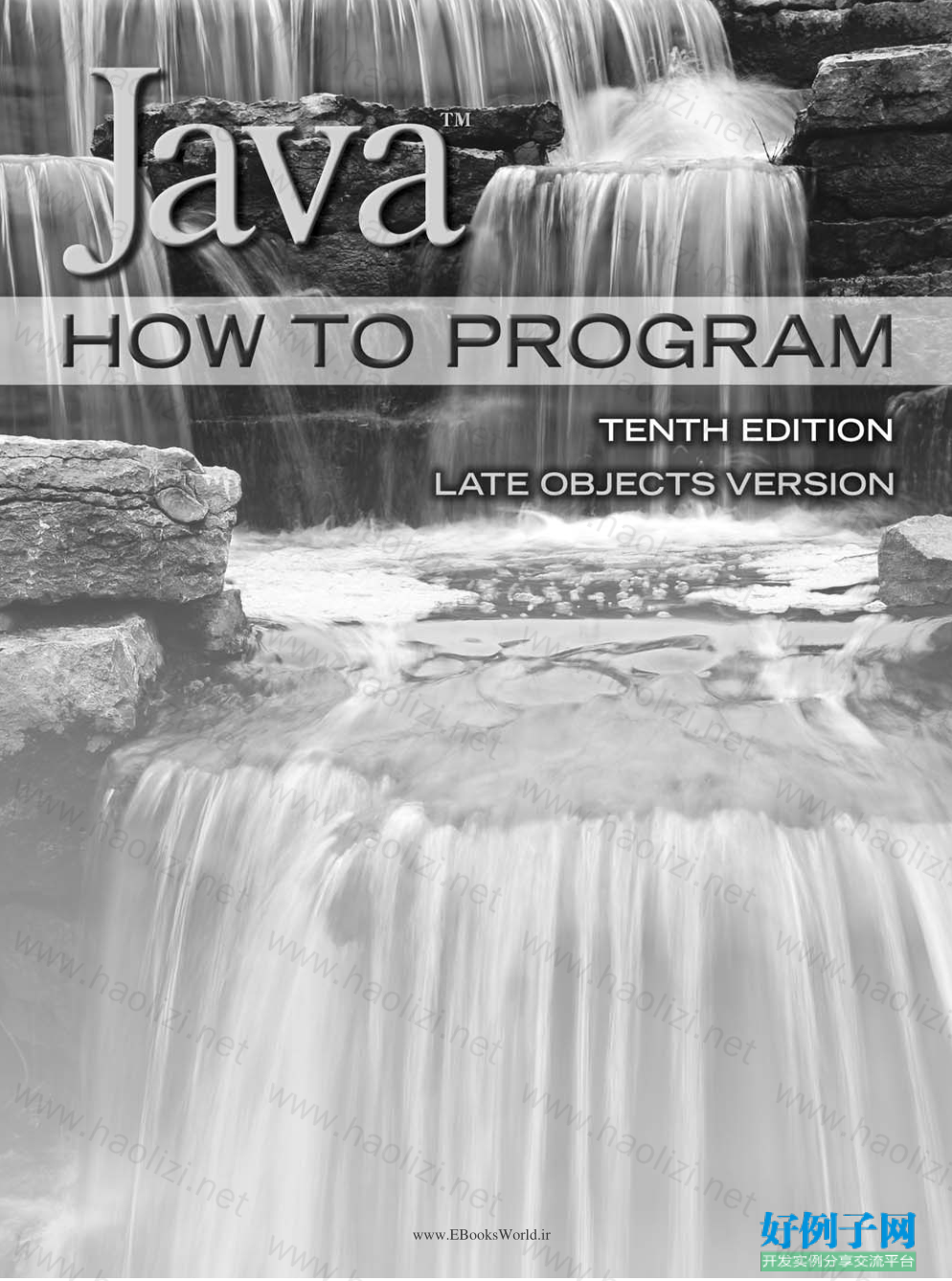

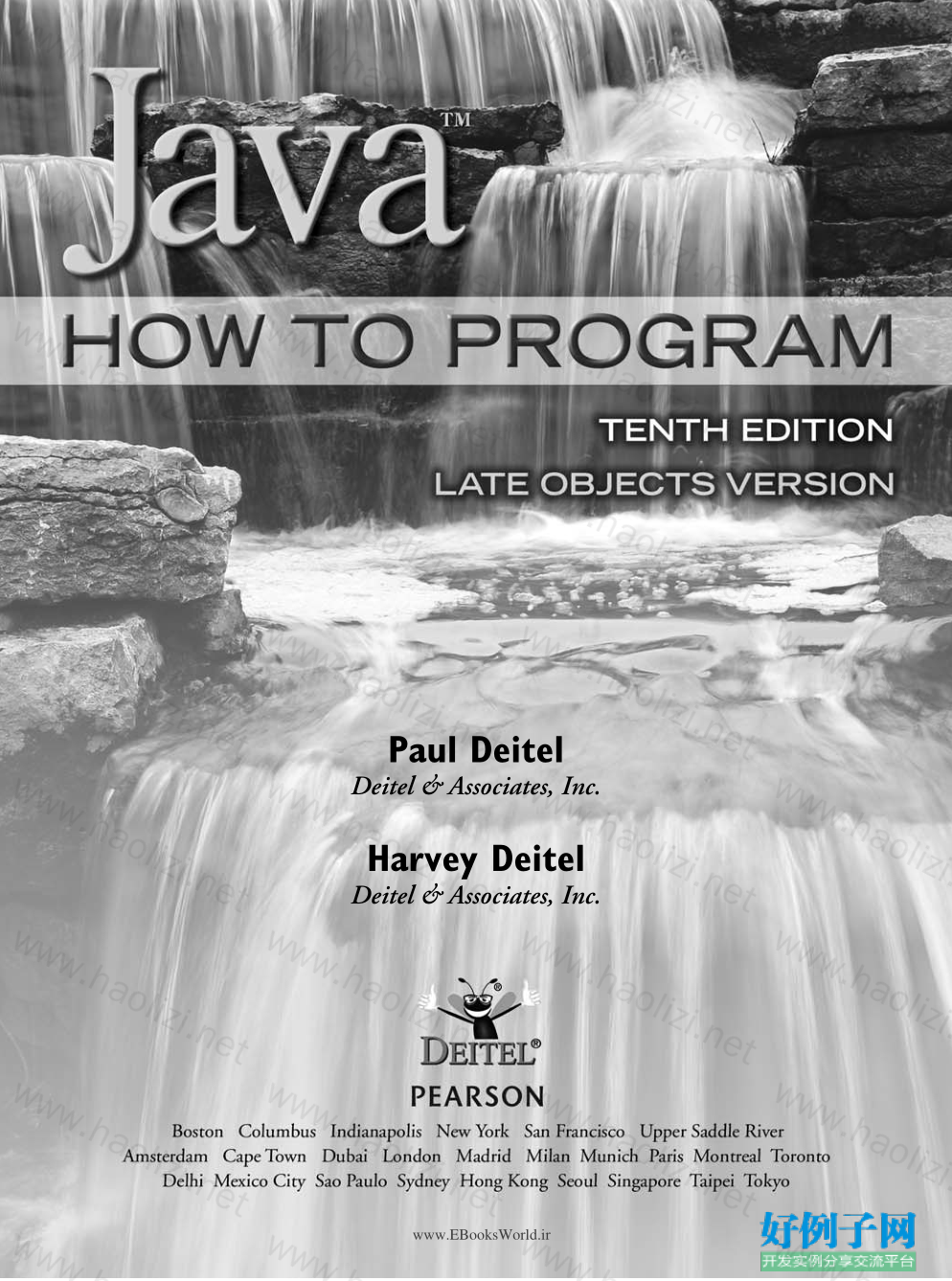
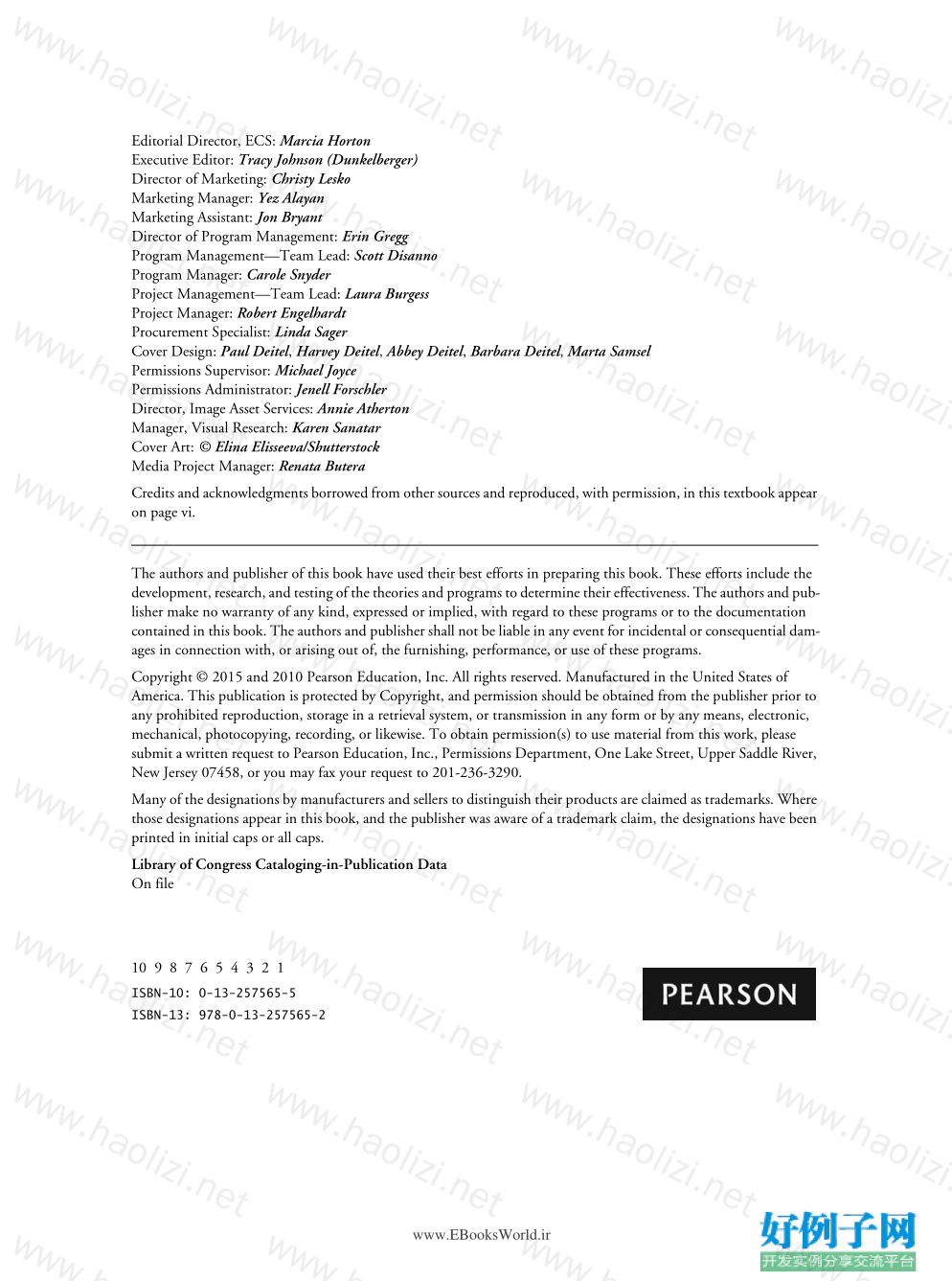
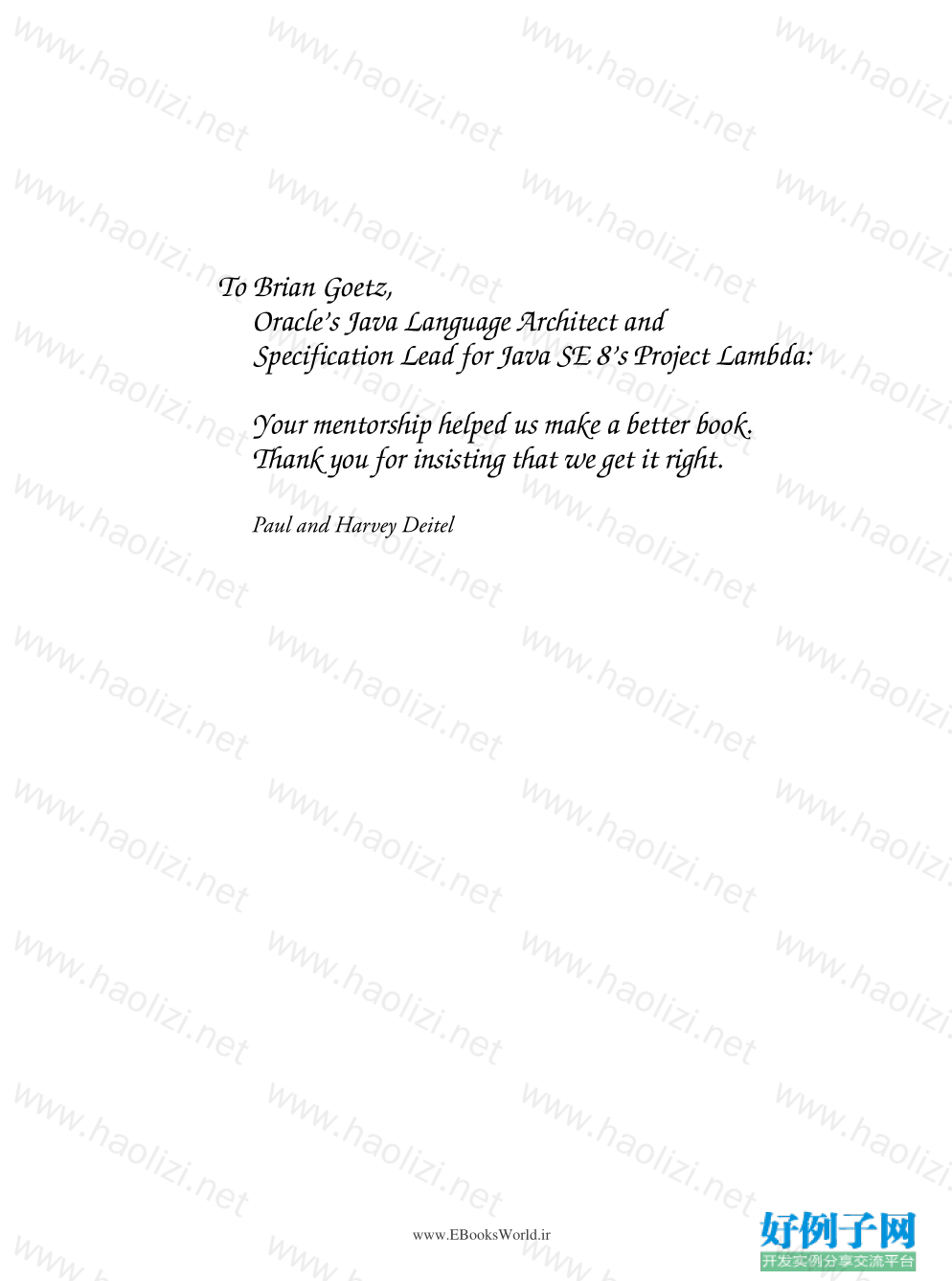
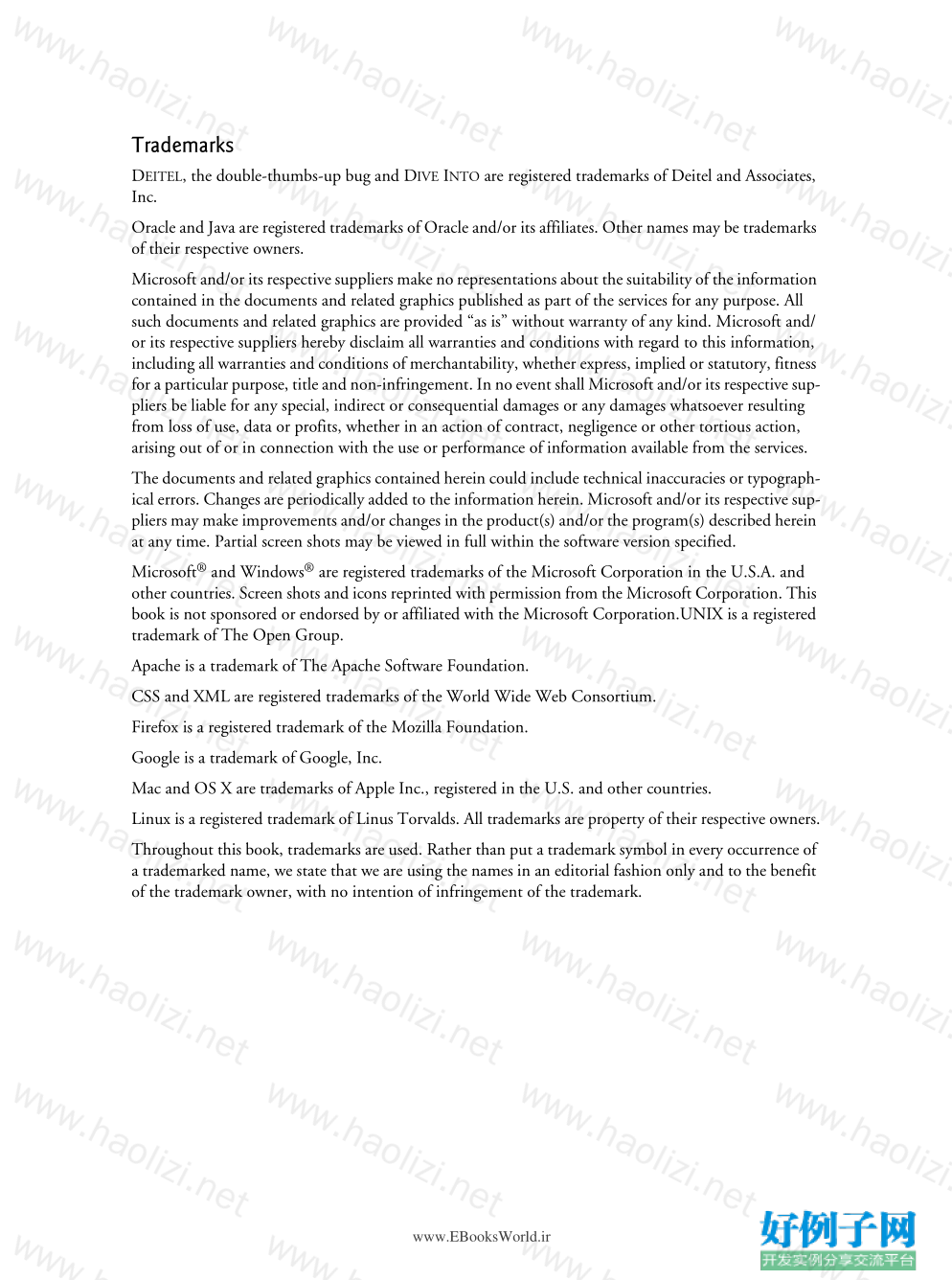
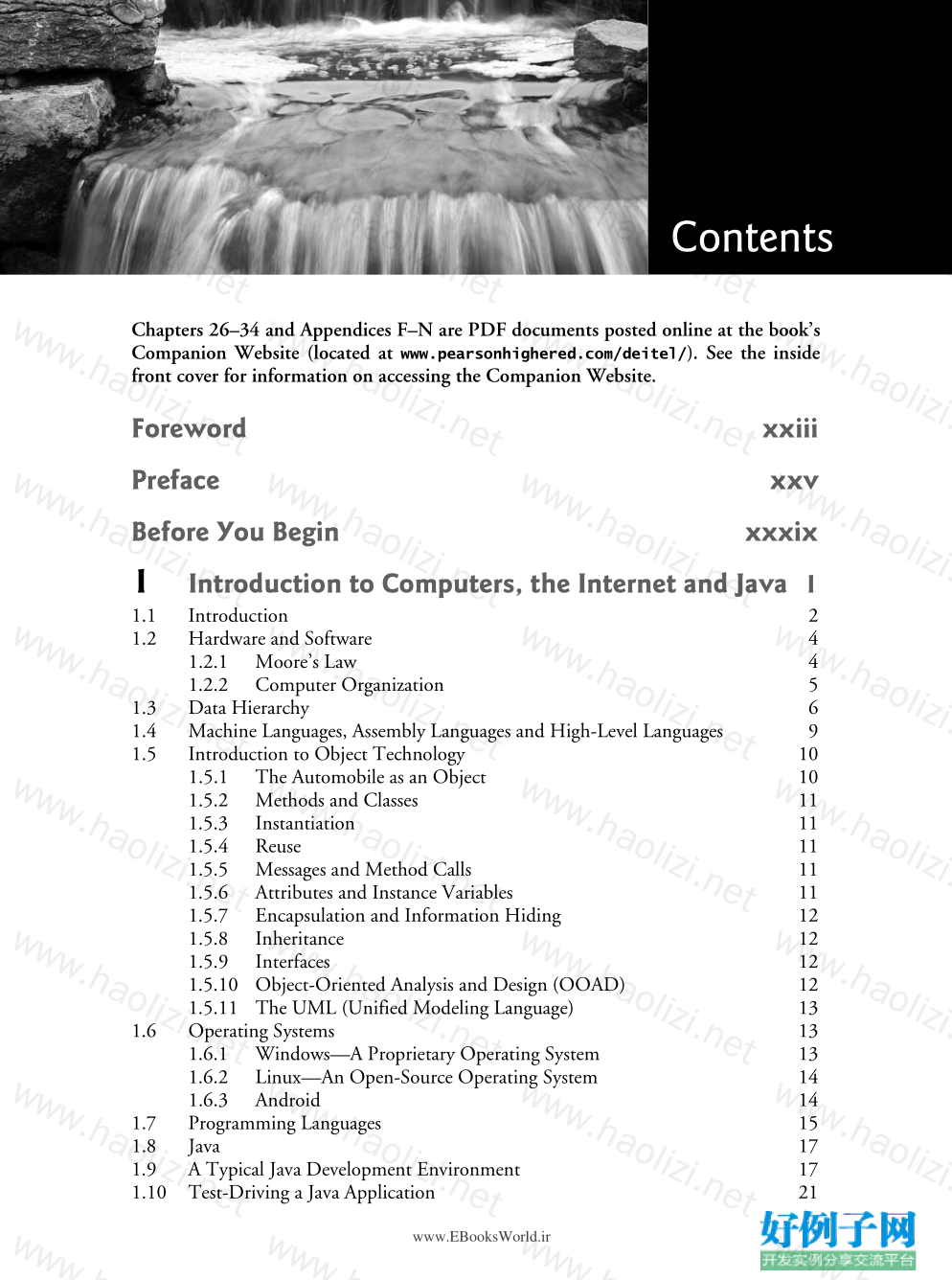
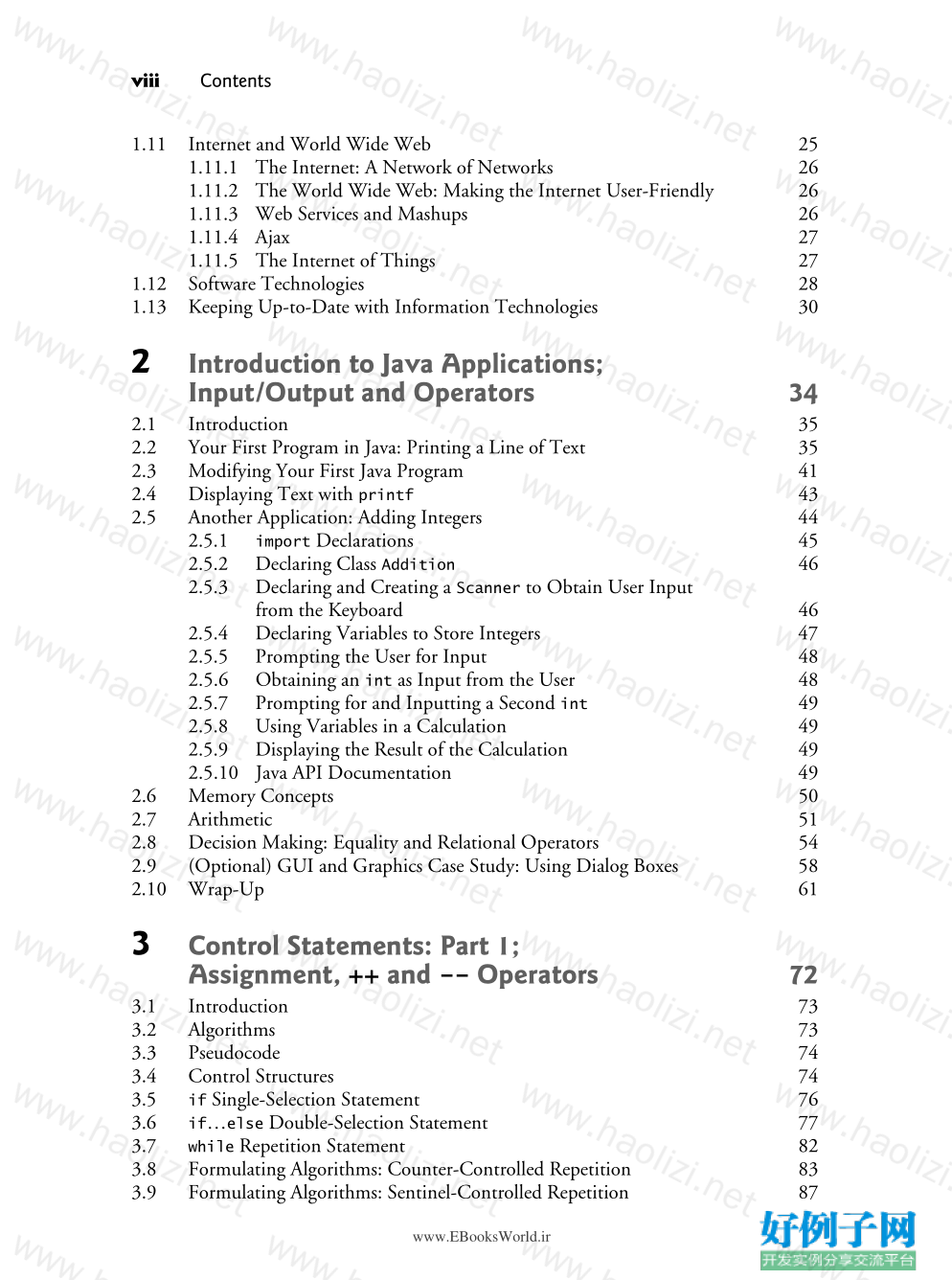
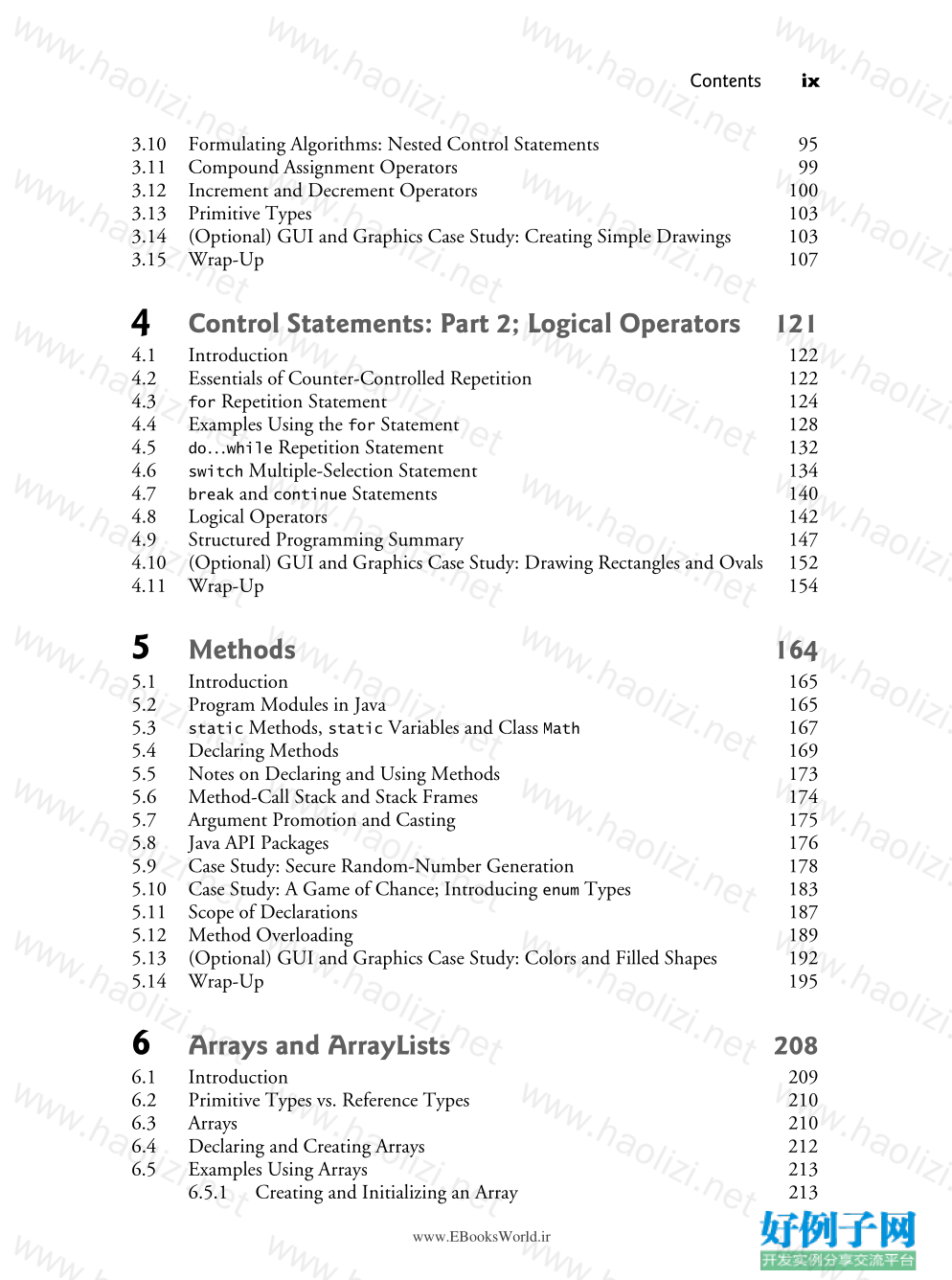
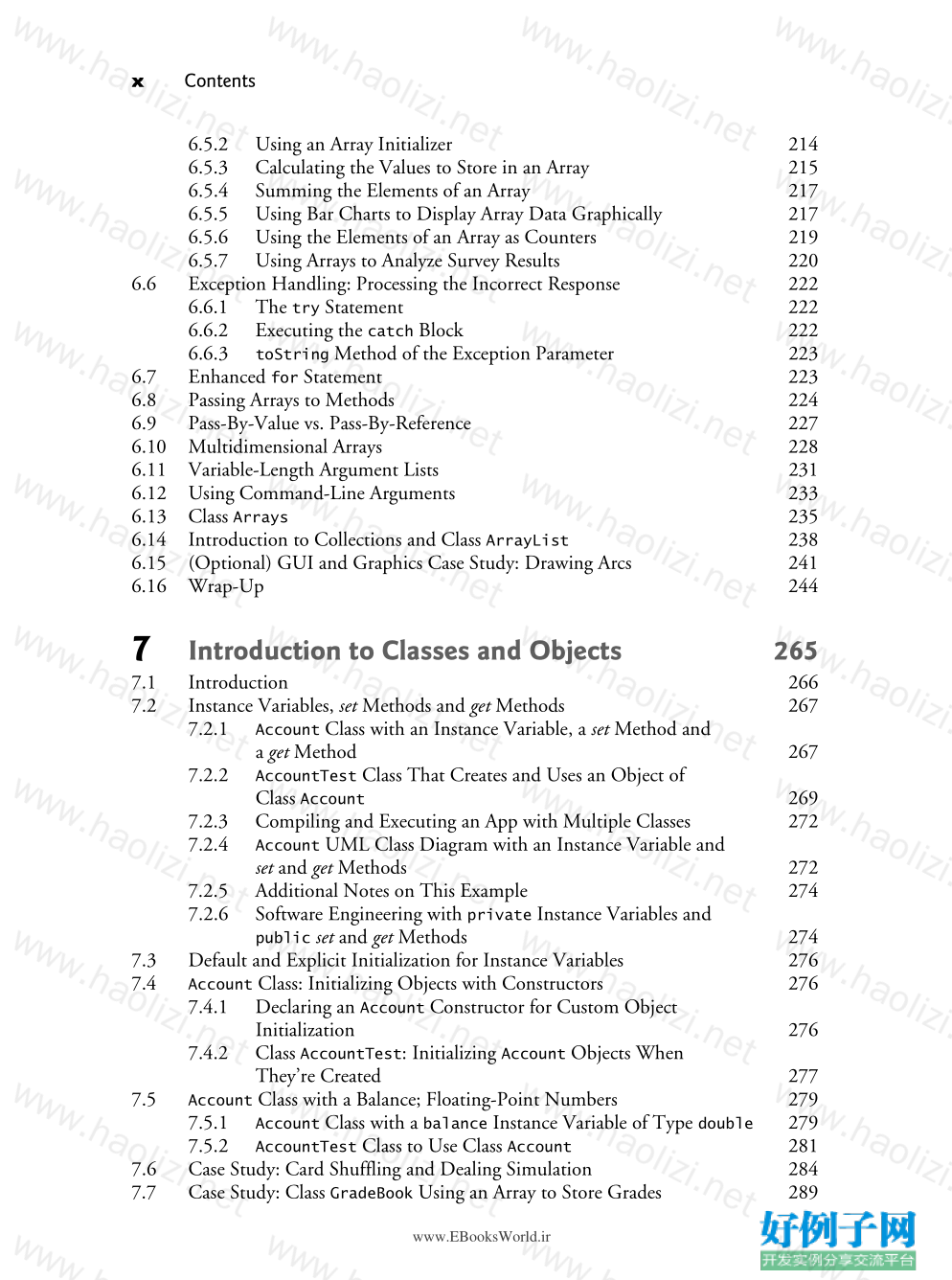
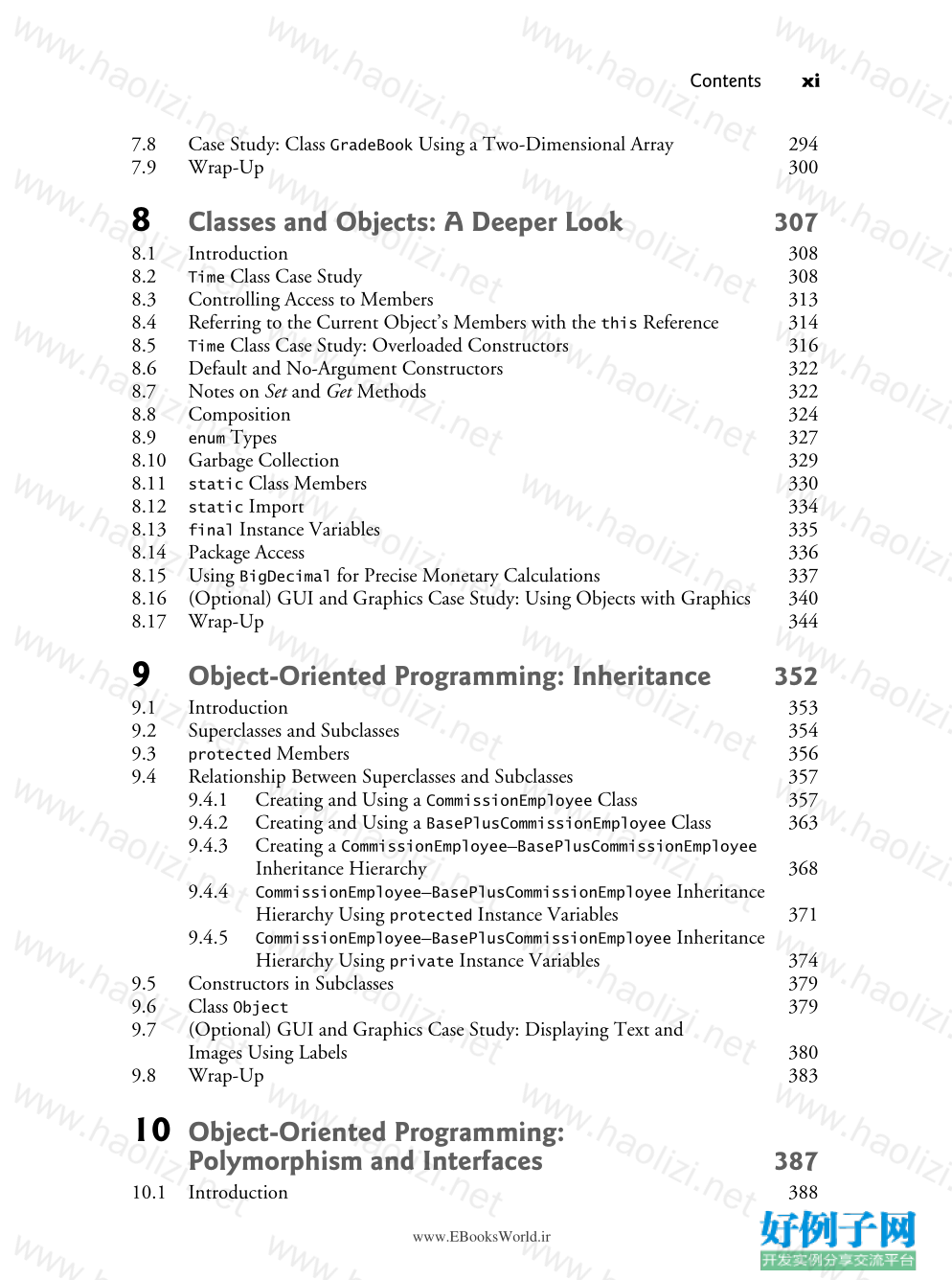

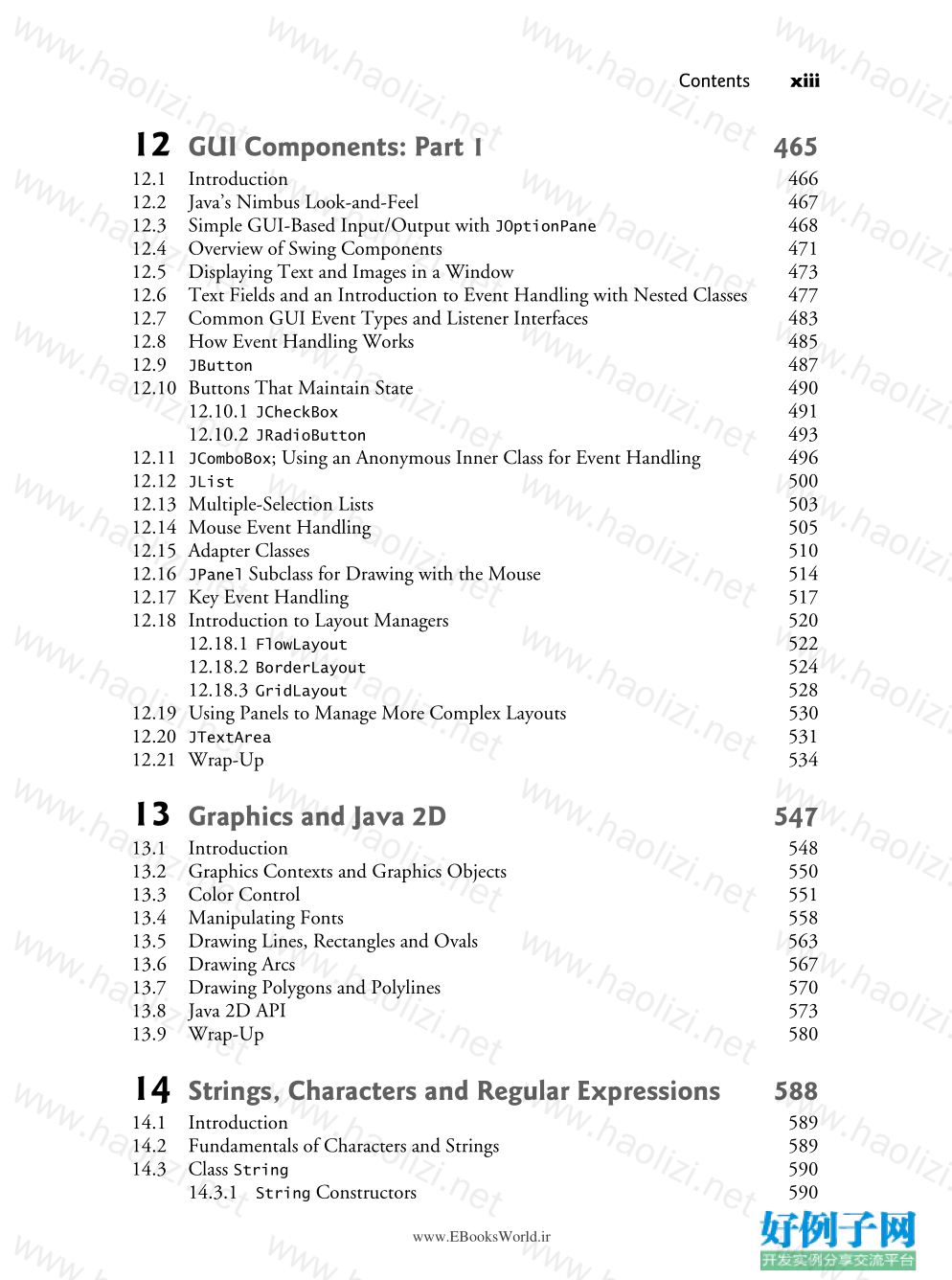
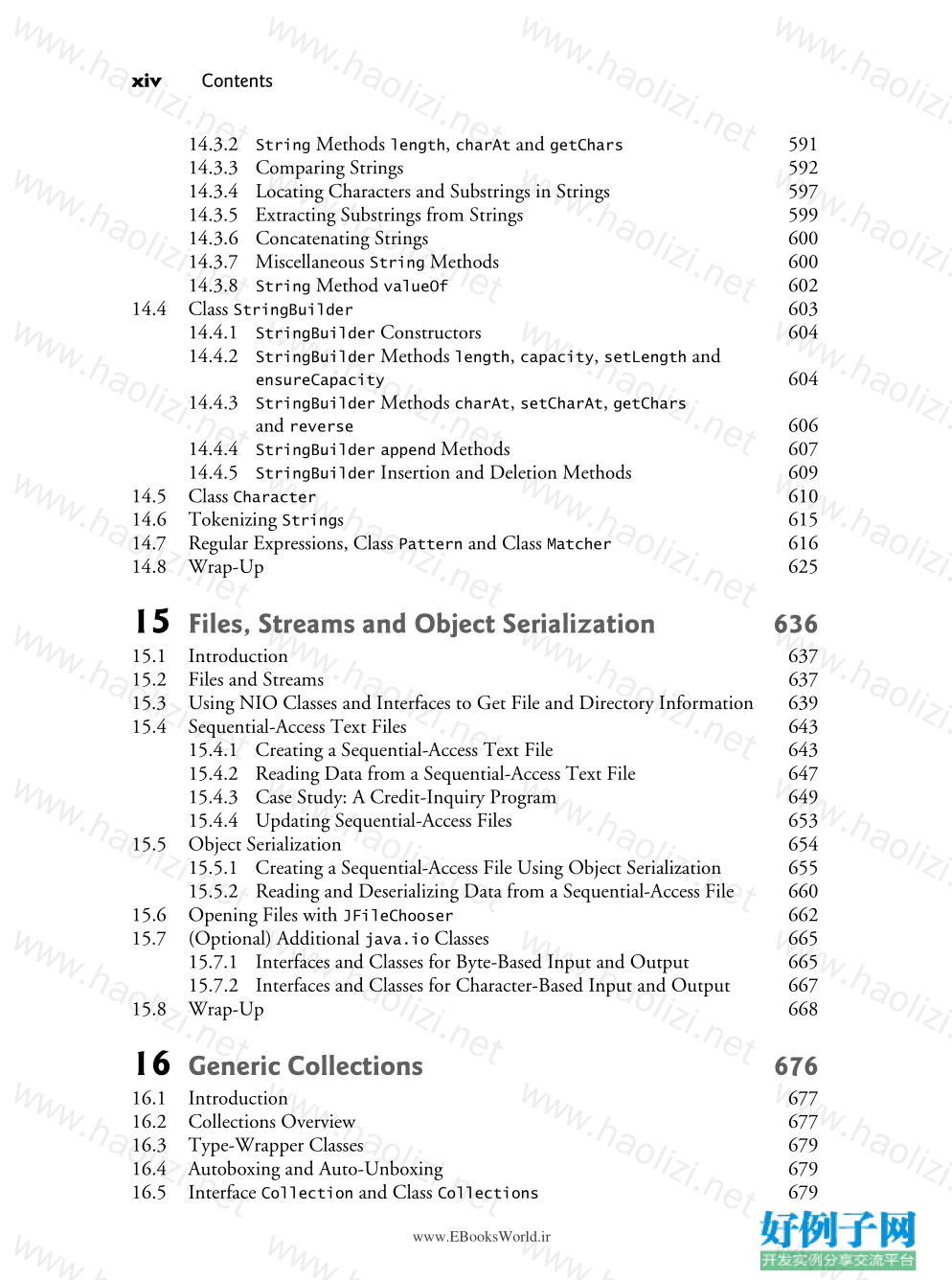
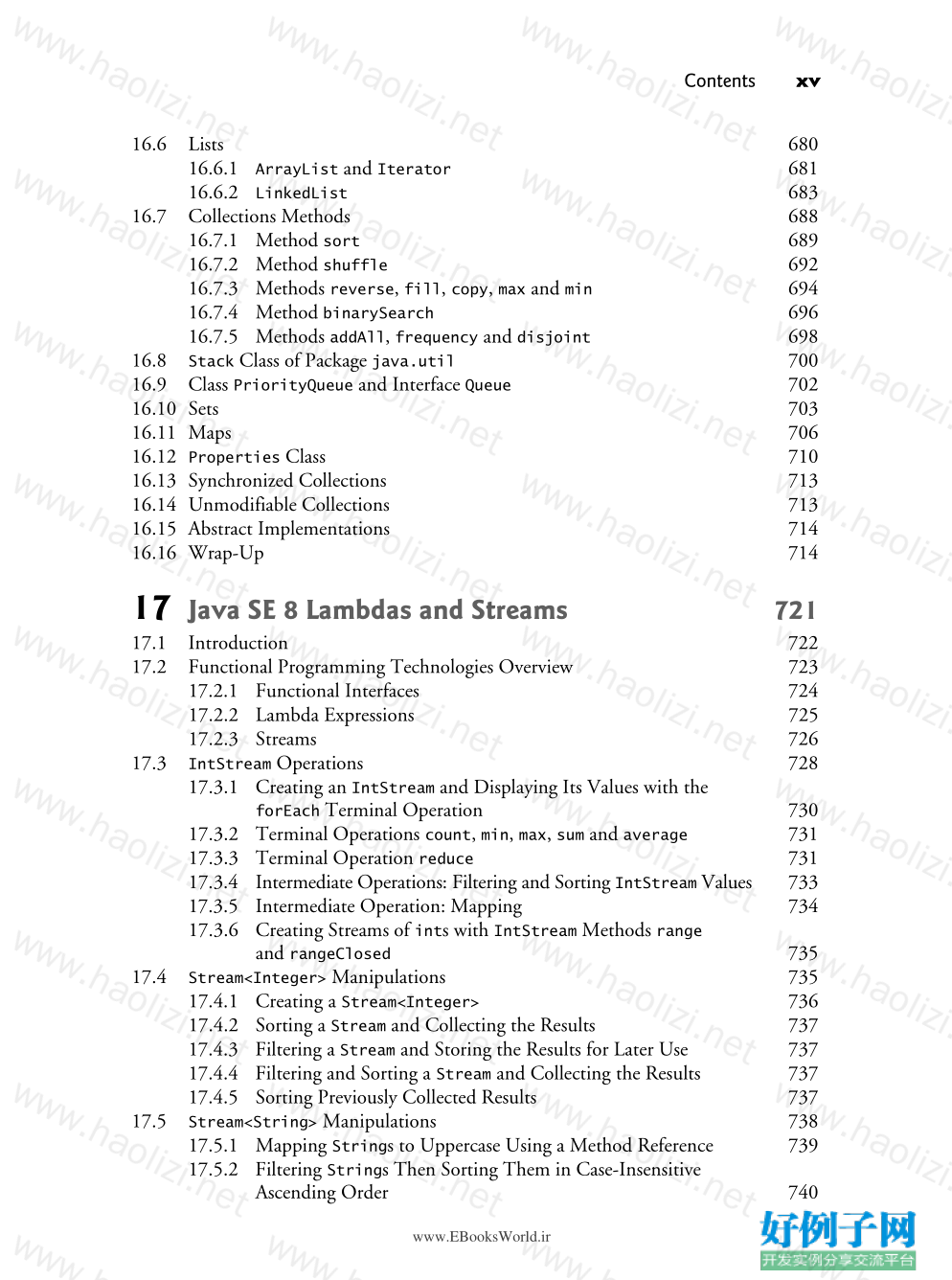
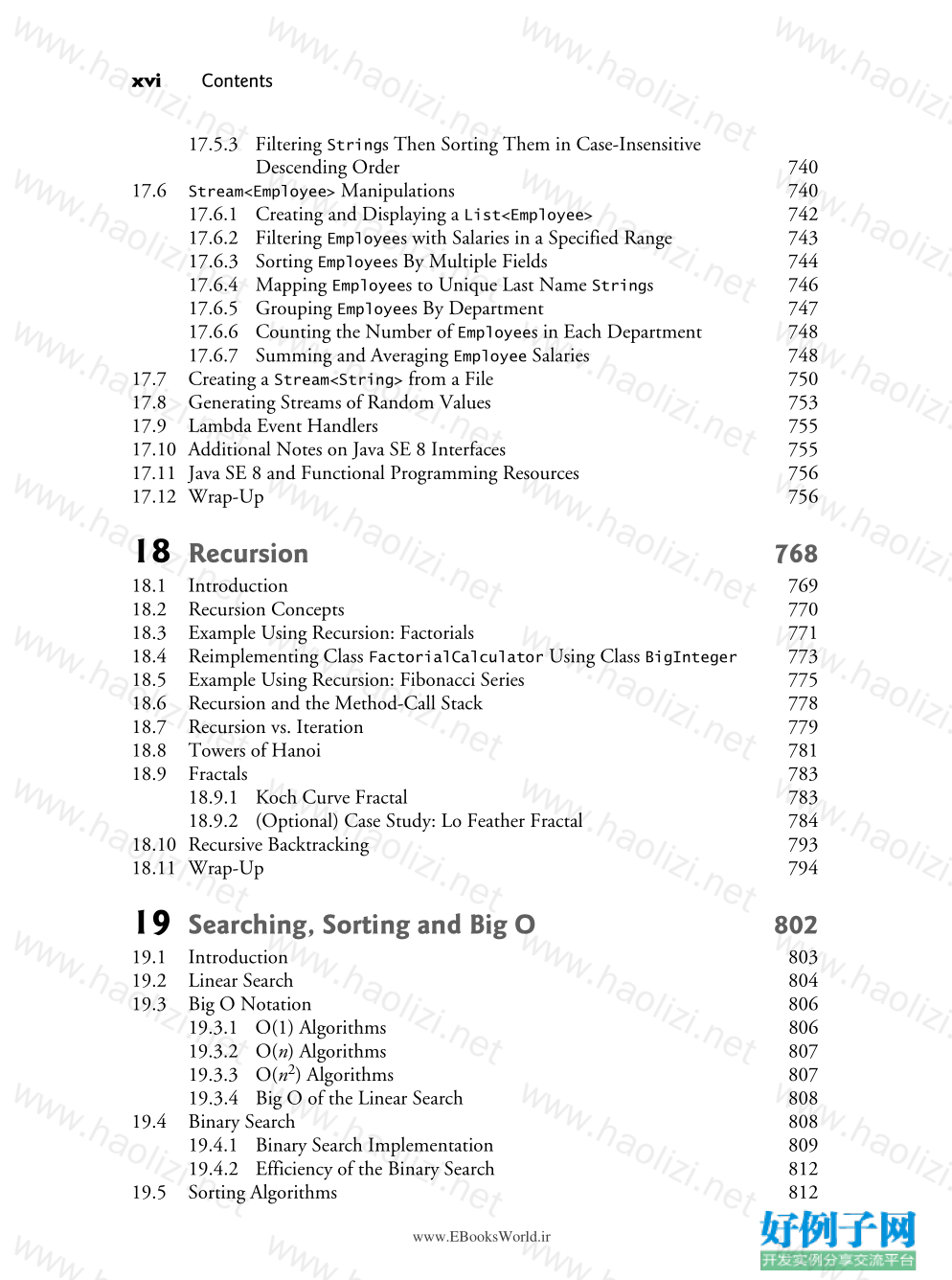
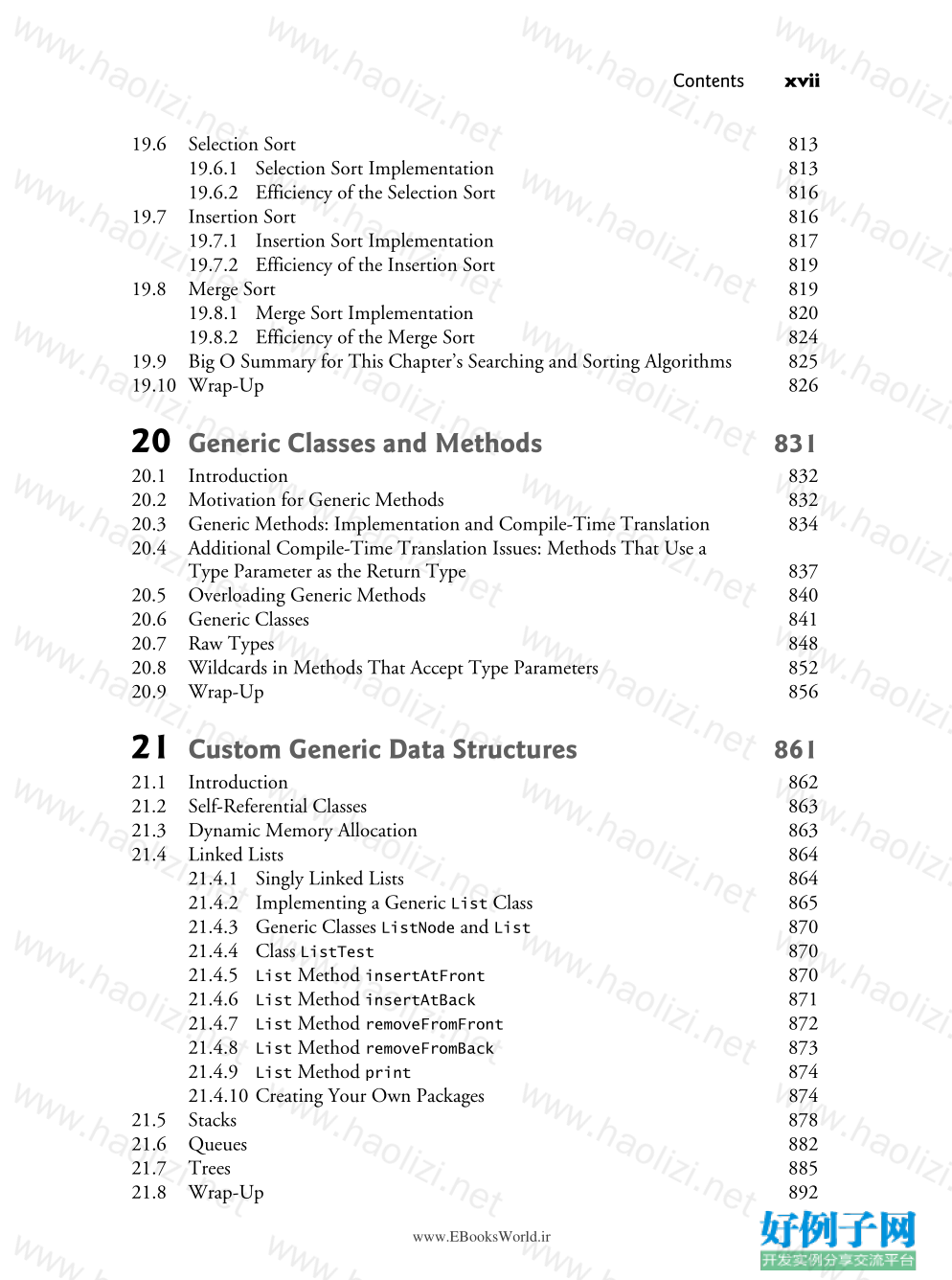
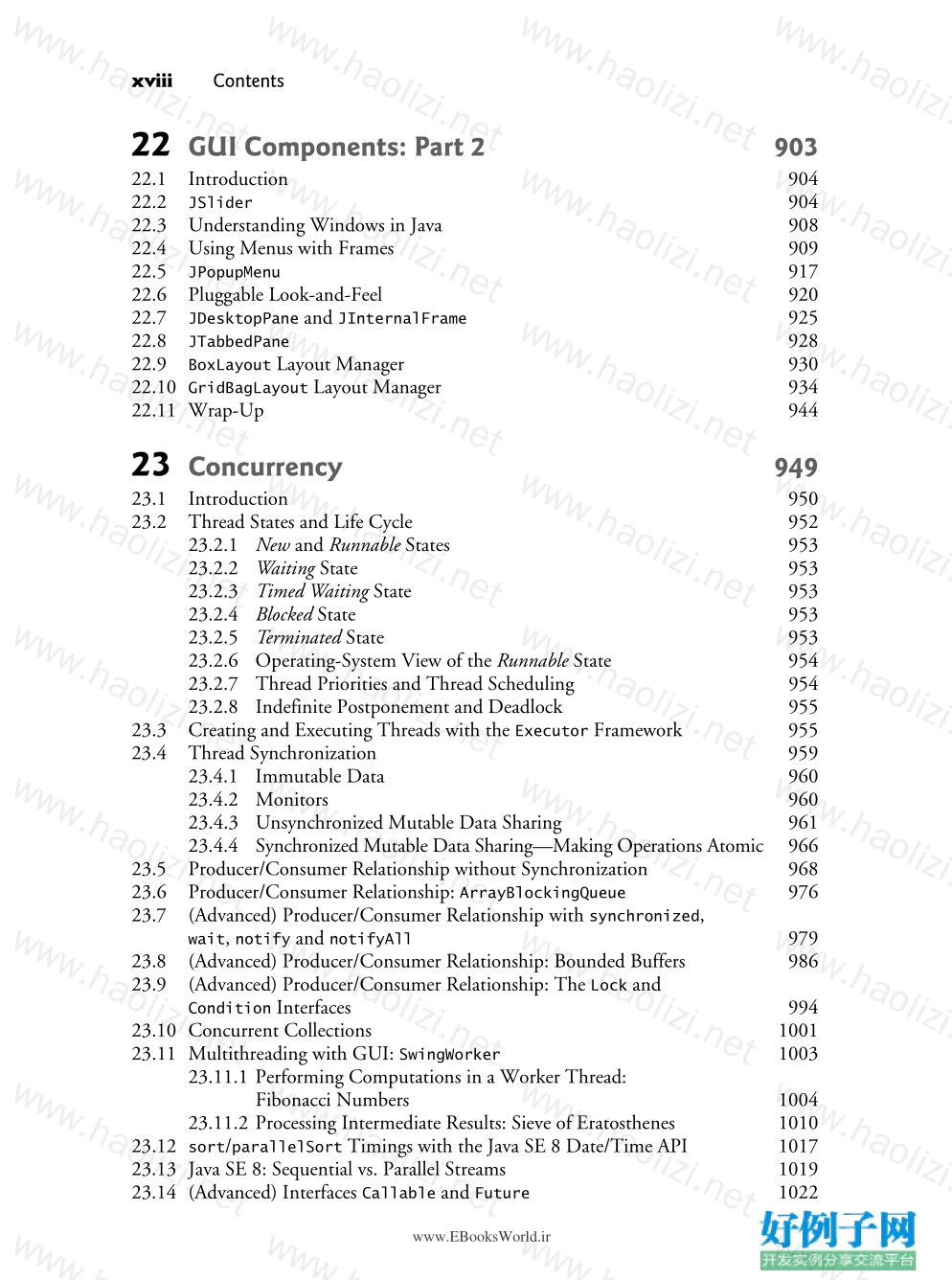
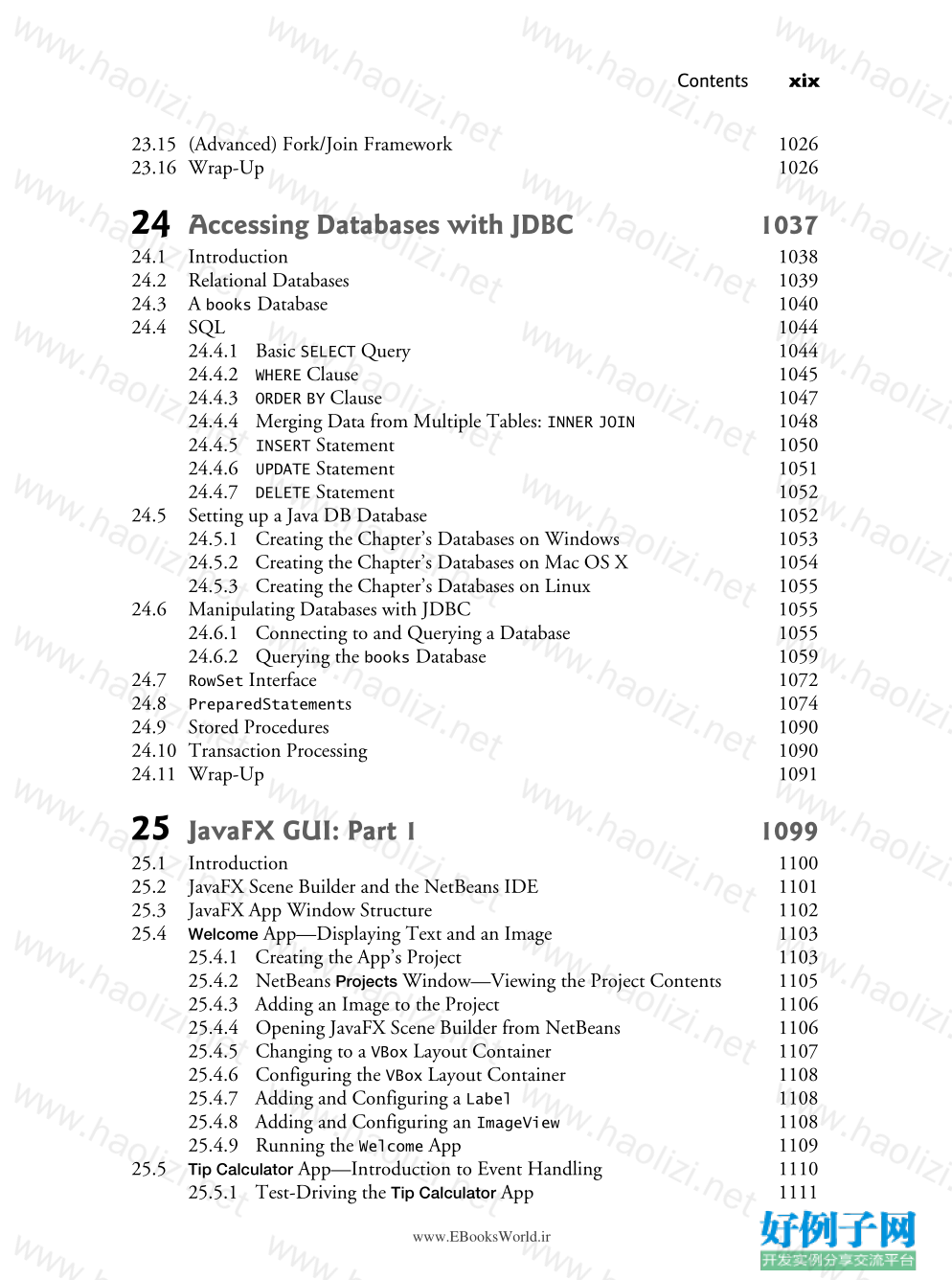

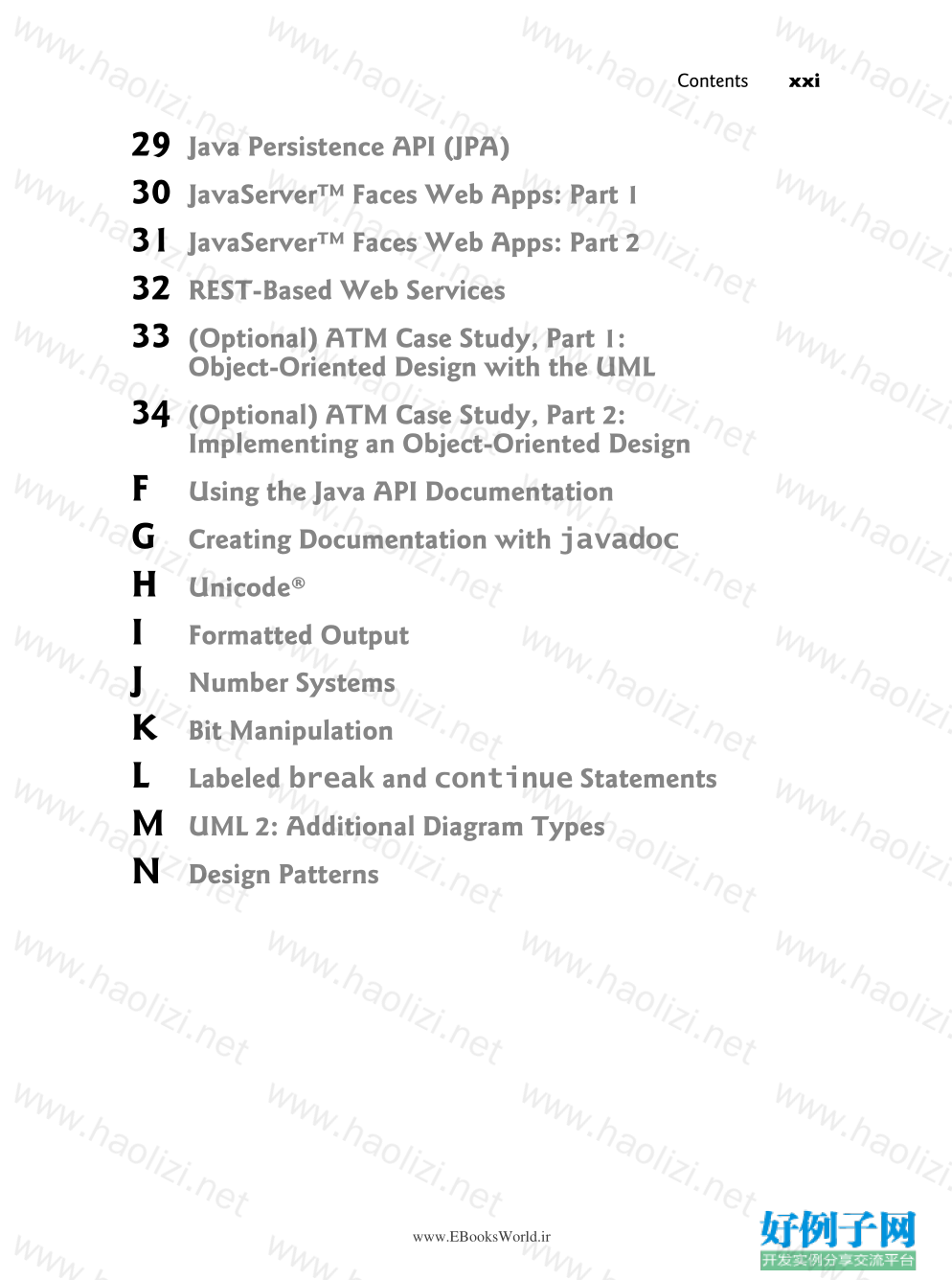
【核心代码】
Trademarks
DEITEL, the double-thumbs-up bug and DIVE INTO are registered trademarks of Deitel and Associates,
Inc.
Oracle and Java are registered trademarks of Oracle and/or its affiliates. Other names may be trademarks
of their respective owners.
Microsoft and/or its respective suppliers make no representations about the suitability of the information
contained in the documents and related graphics published as part of the services for any purpose. All
such documents and related graphics are provided “as is” without warranty of any kind. Microsoft and/
or its respective suppliers hereby disclaim all warranties and conditions with regard to this information,
including all warranties and conditions of merchantability, whether express, implied or statutory, fitness
for a particular purpose, title and non-infringement. In no event shall Microsoft and/or its respective sup
pliers be liable for any special, indirect or consequential damages or any damages whatsoever resulting
from loss of use, data or profits, whether in an action of contract, negligence or other tortious action,
arising out of or in connection with the use or performance of information available from the services.
The documents and related graphics contained herein could include technical inaccuracies or typograph
ical errors. Changes are periodically added to the information herein. Microsoft and/or its respective sup
pliers may make improvements and/or changes in the product(s) and/or the program(s) described herein
at any time. Partial screen shots may be viewed in full within the software version specified.
Microsoft® and Windows® are registered trademarks of the Microsoft Corporation in the U.S.A. and
other countries. Screen shots and icons reprinted with permission from the Microsoft Corporation. This
book is not sponsored or endorsed by or affiliated with the Microsoft Corporation.UNIX is a registered
trademark of The Open Group.
Apache is a trademark of The Apache Software Foundation.
CSS and XML are registered trademarks of the World Wide Web Consortium.
Firefox is a registered trademark of the Mozilla Foundation.
Google is a trademark of Google, Inc.
Mac and OS X are trademarks of Apple Inc., registered in the U.S. and other countries.
Linux is a registered trademark of Linus Torvalds. All trademarks are property of their respective owners.
Throughout this book, trademarks are used. Rather than put a trademark symbol in every occurrence of
a trademarked name, we state that we are using the names in an editorial fashion only and to the benefit
of the trademark owner, with no intention of infringement of the trademark.
www.EBooksWorld.irContents
Chapters 26–34 and Appendices F–N are PDF documents posted online at the book’s
Companion Website (located at www.pearsonhighered.com/deitel/). See the inside
front cover for information on accessing the Companion Website.
Foreword xxiii
Preface xxv
Before You Begin xxxix
1 Introduction to Computers, the Internet and Java 1
1.1 Introduction 2
1.2 Hardware and Software 4
1.2.1 Moore’s Law 4
1.2.2 Computer Organization 5
1.3 Data Hierarchy 6
1.4 Machine Languages, Assembly Languages and High-Level Languages 9
1.5 Introduction to Object Technology 10
1.5.1 The Automobile as an Object 10
1.5.2 Methods and Classes 11
1.5.3 Instantiation 11
1.5.4 Reuse 11
1.5.5 Messages and Method Calls 11
1.5.6 Attributes and Instance Variables 11
1.5.7 Encapsulation and Information Hiding 12
1.5.8 Inheritance 12
1.5.9 Interfaces 12
1.5.10 Object-Oriented Analysis and Design (OOAD) 12
1.5.11 The UML (Unified Modeling Language) 13
1.6 Operating Systems 13
1.6.1 Windows—A Proprietary Operating System 13
1.6.2 Linux—An Open-Source Operating System 14
1.6.3 Android 14
1.7 Programming Languages 15
1.8 Java 17
1.9 A Typical Java Development Environment 17
1.10 Test-Driving a Java Application 21
www.EBooksWorld.irviii
Contents
1.11 Internet and World Wide Web 25
1.11.1 The Internet: A Network of Networks 26
1.11.2 The World Wide Web: Making the Internet User-Friendly 26
1.11.3 Web Services and Mashups 26
1.11.4 Ajax 27
1.11.5 The Internet of Things 27
1.12 Software Technologies 28
1.13 Keeping Up-to-Date with Information Technologies 30
2
Introduction to Java Applications;
Input/Output and Operators 34
2.1 Introduction 35
2.2 Your First Program in Java: Printing a Line of Text 35
2.3 Modifying Your First Java Program 41
2.4 Displaying Text with printf
43
2.5 Another Application: Adding Integers 44
2.5.1
import Declarations 45
2.5.2 Declaring Class Addition
46
2.5.3 Declaring and Creating a Scanner to Obtain User Input
from the Keyboard 46
2.5.4 Declaring Variables to Store Integers 47
2.5.5 Prompting the User for Input 48
2.5.6 Obtaining an int as Input from the User 48
2.5.7 Prompting for and Inputting a Second int
49
2.5.8 Using Variables in a Calculation 49
2.5.9 Displaying the Result of the Calculation 49
2.5.10 Java API Documentation 49
2.6 Memory Concepts 50
2.7 Arithmetic 51
2.8 Decision Making: Equality and Relational Operators 54
2.9 (Optional) GUI and Graphics Case Study: Using Dialog Boxes 58
2.10 Wrap-Up 61
3
Control Statements: Part 1;
Assignment, and -- Operators 72
3.1 Introduction 73
3.2 Algorithms 73
3.3 Pseudocode 74
3.4 Control Structures 74
3.5
if Single-Selection Statement 76
3.6
if…else Double-Selection Statement 77
3.7
while Repetition Statement 82
3.8 Formulating Algorithms: Counter-Controlled Repetition 83
3.9 Formulating Algorithms: Sentinel-Controlled Repetition 87
www.EBooksWorld.irContents
ix
3.10 Formulating Algorithms: Nested Control Statements 95
3.11 Compound Assignment Operators 99
3.12 Increment and Decrement Operators 100
3.13 Primitive Types 103
3.14 (Optional) GUI and Graphics Case Study: Creating Simple Drawings 103
3.15 Wrap-Up 107
4
Control Statements: Part 2; Logical Operators 121
4.1 Introduction 122
4.2 Essentials of Counter-Controlled Repetition 122
4.3
for Repetition Statement 124
4.4 Examples Using the for Statement 128
4.5
do…while Repetition Statement 132
4.6
switch Multiple-Selection Statement 134
4.7
break and continue Statements 140
4.8 Logical Operators 142
4.9 Structured Programming Summary 147
4.10 (Optional) GUI and Graphics Case Study: Drawing Rectangles and Ovals 152
4.11 Wrap-Up 154
5
Methods 164
5.1 Introduction 165
5.2 Program Modules in Java 165
5.3
static Methods, static Variables and Class Math
167
5.4 Declaring Methods 169
5.5 Notes on Declaring and Using Methods 173
5.6 Method-Call Stack and Stack Frames 174
5.7 Argument Promotion and Casting 175
5.8 Java API Packages 176
5.9 Case Study: Secure Random-Number Generation 178
5.10 Case Study: A Game of Chance; Introducing enum Types 183
5.11 Scope of Declarations 187
5.12 Method Overloading 189
5.13 (Optional) GUI and Graphics Case Study: Colors and Filled Shapes 192
5.14 Wrap-Up 195
6
Arrays and ArrayLists 208
6.1 Introduction 209
6.2 Primitive Types vs. Reference Types 210
6.3 Arrays 210
6.4 Declaring and Creating Arrays 212
6.5 Examples Using Arrays 213
6.5.1 Creating and Initializing an Array 213
www.EBooksWorld.irx
Contents
6.5.2 Using an Array Initializer 214
6.5.3 Calculating the Values to Store in an Array 215
6.5.4 Summing the Elements of an Array 217
6.5.5 Using Bar Charts to Display Array Data Graphically 217
6.5.6 Using the Elements of an Array as Counters 219
6.5.7 Using Arrays to Analyze Survey Results 220
6.6 Exception Handling: Processing the Incorrect Response 222
6.6.1 The try Statement 222
6.6.2 Executing the catch Block 222
6.6.3
toString Method of the Exception Parameter 223
6.7 Enhanced for Statement 223
6.8 Passing Arrays to Methods 224
6.9 Pass-By-Value vs. Pass-By-Reference 227
6.10 Multidimensional Arrays 228
6.11 Variable-Length Argument Lists 231
6.12 Using Command-Line Arguments 233
6.13 Class Arrays
235
6.14 Introduction to Collections and Class ArrayList
238
6.15 (Optional) GUI and Graphics Case Study: Drawing Arcs 241
6.16 Wrap-Up 244
7
Introduction to Classes and Objects 265
7.1 Introduction 266
7.2 Instance Variables, set Methods and get Methods 267
7.2.1
Account Class with an Instance Variable, a set Method and
a get Method 267
7.2.2
AccountTest Class That Creates and Uses an Object of
Class Account
269
7.2.3 Compiling and Executing an App with Multiple Classes 272
7.2.4
Account UML Class Diagram with an Instance Variable and
set and get Methods 272
7.2.5 Additional Notes on This Example 274
7.2.6 Software Engineering with private Instance Variables and
public set and get Methods 274
7.3 Default and Explicit Initialization for Instance Variables 276
7.4
Account Class: Initializing Objects with Constructors 276
7.4.1 Declaring an Account Constructor for Custom Object
Initialization 276
7.4.2 Class AccountTest: Initializing Account Objects When
They’re Created 277
7.5
Account Class with a Balance; Floating-Point Numbers 279
7.5.1
Account Class with a balance Instance Variable of Type double
279
7.5.2
AccountTest Class to Use Class Account
281
7.6 Case Study: Card Shuffling and Dealing Simulation 284
7.7 Case Study: Class GradeBook Using an Array to Store Grades 289
www.EBooksWorld.irContents
xi
7.8 Case Study: Class GradeBook Using a Two-Dimensional Array 294
7.9 Wrap-Up 300
8
Classes and Objects: A Deeper Look 307
8.1 Introduction 308
8.2
Time Class Case Study 308
8.3 Controlling Access to Members 313
8.4 Referring to the Current Object’s Members with the this Reference 314
8.5
Time Class Case Study: Overloaded Constructors 316
8.6 Default and No-Argument Constructors 322
8.7 Notes on Set and Get Methods 322
8.8 Composition 324
8.9
enum Types 327
8.10 Garbage Collection 329
8.11
static Class Members 330
8.12
static Import 334
8.13
final Instance Variables 335
8.14 Package Access 336
8.15 Using BigDecimal for Precise Monetary Calculations 337
8.16 (Optional) GUI and Graphics Case Study: Using Objects with Graphics 340
8.17 Wrap-Up 344
9
Object-Oriented Programming: Inheritance 352
9.1 Introduction 353
9.2 Superclasses and Subclasses 354
9.3
protected Members 356
9.4 Relationship Between Superclasses and Subclasses 357
9.4.1 Creating and Using a CommissionEmployee Class 357
9.4.2 Creating and Using a BasePlusCommissionEmployee Class 363
9.4.3 Creating a CommissionEmployee–BasePlusCommissionEmployee
Inheritance Hierarchy 368
9.4.4
CommissionEmployee–BasePlusCommissionEmployee Inheritance
Hierarchy Using protected Instance Variables 371
9.4.5
CommissionEmployee–BasePlusCommissionEmployee Inheritance
Hierarchy Using private Instance Variables 374
9.5 Constructors in Subclasses 379
9.6 Class Object
379
9.7 (Optional) GUI and Graphics Case Study: Displaying Text and
Images Using Labels 380
9.8 Wrap-Up 383
10 Object-Oriented Programming:
Polymorphism and Interfaces 387
10.1 Introduction 388
www.EBooksWorld.irxii
Contents
10.2 Polymorphism Examples 390
10.3 Demonstrating Polymorphic Behavior 391
10.4 Abstract Classes and Methods 393
10.5 Case Study: Payroll System Using Polymorphism 396
10.5.1 Abstract Superclass Employee
397
10.5.2 Concrete Subclass SalariedEmployee
399
10.5.3 Concrete Subclass HourlyEmployee
401
10.5.4 Concrete Subclass CommissionEmployee
403
10.5.5 Indirect Concrete Subclass BasePlusCommissionEmployee
405
10.5.6 Polymorphic Processing, Operator instanceof and Downcasting 406
10.6 Allowed Assignments Between Superclass and Subclass Variables 411
10.7
final Methods and Classes 411
10.8 A Deeper Explanation of Issues with Calling Methods from Constructors 412
10.9 Creating and Using Interfaces 413
10.9.1 Developing a Payable Hierarchy 414
10.9.2 Interface Payable
415
10.9.3 Class Invoice
416
10.9.4 Modifying Class Employee to Implement Interface Payable
418
10.9.5 Modifying Class SalariedEmployee for Use in the Payable
Hierarchy 420
10.9.6 Using Interface Payable to Process Invoices and Employees
Polymorphically 422
10.9.7 Some Common Interfaces of the Java API 423
10.10 Java SE 8 Interface Enhancements 424
10.10.1 default Interface Methods 424
10.10.2 static Interface Methods 425
10.10.3 Functional Interfaces 425
10.11 (Optional) GUI and Graphics Case Study: Drawing with Polymorphism 425
10.12 Wrap-Up 428
11 Exception Handling: A Deeper Look 433
11.1 Introduction 434
11.2 Example: Divide by Zero without Exception Handling 435
11.3 Example: Handling ArithmeticExceptions and
InputMismatchExceptions
437
11.4 When to Use Exception Handling 443
11.5 Java Exception Hierarchy 443
11.6
finally Block 446
11.7 Stack Unwinding and Obtaining Information from an Exception Object 451
11.8 Chained Exceptions 453
11.9 Declaring New Exception Types 456
11.10 Preconditions and Postconditions 457
11.11 Assertions 457
11.12 try-with-Resources: Automatic Resource Deallocation 459
11.13 Wrap-Up 459
www.EBooksWorld.irContents
xiii
12 GUI Components: Part 1 465
12.1 Introduction 466
12.2 Java’s Nimbus Look-and-Feel 467
12.3 Simple GUI-Based Input/Output with JOptionPane
468
12.4 Overview of Swing Components 471
12.5 Displaying Text and Images in a Window 473
12.6 Text Fields and an Introduction to Event Handling with Nested Classes 477
12.7 Common GUI Event Types and Listener Interfaces 483
12.8 How Event Handling Works 485
12.9
JButton
487
12.10 Buttons That Maintain State 490
12.10.1 JCheckBox
491
12.10.2 JRadioButton
493
12.11 JComboBox; Using an Anonymous Inner Class for Event Handling 496
12.12 JList
500
12.13 Multiple-Selection Lists 503
12.14 Mouse Event Handling 505
12.15 Adapter Classes 510
12.16 JPanel Subclass for Drawing with the Mouse 514
12.17 Key Event Handling 517
12.18 Introduction to Layout Managers 520
12.18.1 FlowLayout
522
12.18.2 BorderLayout
524
12.18.3 GridLayout
528
12.19 Using Panels to Manage More Complex Layouts 530
12.20 JTextArea
531
12.21 Wrap-Up 534
13 Graphics and Java 2D 547
13.1 Introduction 548
13.2 Graphics Contexts and Graphics Objects 550
13.3 Color Control 551
13.4 Manipulating Fonts 558
13.5 Drawing Lines, Rectangles and Ovals 563
13.6 Drawing Arcs 567
13.7 Drawing Polygons and Polylines 570
13.8 Java 2D API 573
13.9 Wrap-Up 580
14 Strings, Characters and Regular Expressions 588
14.1 Introduction 589
14.2 Fundamentals of Characters and Strings 589
14.3 Class String
590
14.3.1 String Constructors 590
www.EBooksWorld.irxiv
Contents
14.3.2 String Methods length, charAt and getChars
591
14.3.3 Comparing Strings 592
14.3.4 Locating Characters and Substrings in Strings 597
14.3.5 Extracting Substrings from Strings 599
14.3.6 Concatenating Strings 600
14.3.7 Miscellaneous String Methods 600
14.3.8 String Method valueOf
602
14.4 Class StringBuilder
603
14.4.1 StringBuilder Constructors 604
14.4.2 StringBuilder Methods length, capacity, setLength and
ensureCapacity
604
14.4.3 StringBuilder Methods charAt, setCharAt, getChars
and reverse
606
14.4.4 StringBuilder append Methods 607
14.4.5 StringBuilder Insertion and Deletion Methods 609
14.5 Class Character
610
14.6 Tokenizing Strings 615
14.7 Regular Expressions, Class Pattern and Class Matcher
616
14.8 Wrap-Up 625
15 Files, Streams and Object Serialization 636
15.1 Introduction 637
15.2 Files and Streams 637
15.3 Using NIO Classes and Interfaces to Get File and Directory Information 639
15.4 Sequential-Access Text Files 643
15.4.1 Creating a Sequential-Access Text File 643
15.4.2 Reading Data from a Sequential-Access Text File 647
15.4.3 Case Study: A Credit-Inquiry Program 649
15.4.4 Updating Sequential-Access Files 653
15.5 Object Serialization 654
15.5.1 Creating a Sequential-Access File Using Object Serialization 655
15.5.2 Reading and Deserializing Data from a Sequential-Access File 660
15.6 Opening Files with JFileChooser
662
15.7 (Optional) Additional java.io Classes 665
15.7.1 Interfaces and Classes for Byte-Based Input and Output 665
15.7.2 Interfaces and Classes for Character-Based Input and Output 667
15.8 Wrap-Up 668
16 Generic Collections 676
16.1 Introduction 677
16.2 Collections Overview 677
16.3 Type-Wrapper Classes 679
16.4 Autoboxing and Auto-Unboxing 679
16.5 Interface Collection and Class Collections
679
www.EBooksWorld.irContents
xv
16.6 Lists 680
16.6.1 ArrayList and Iterator
681
16.6.2 LinkedList
683
16.7 Collections Methods 688
16.7.1 Method sort
689
16.7.2 Method shuffle
692
16.7.3 Methods reverse, fill, copy, max and min
694
16.7.4 Method binarySearch
696
16.7.5 Methods addAll, frequency and disjoint
698
16.8
Stack Class of Package java.util
700
16.9 Class PriorityQueue and Interface Queue
702
16.10 Sets 703
16.11 Maps 706
16.12 Properties Class 710
16.13 Synchronized Collections 713
16.14 Unmodifiable Collections 713
16.15 Abstract Implementations 714
16.16 Wrap-Up 714
17 Java SE 8 Lambdas and Streams 721
17.1 Introduction 722
17.2 Functional Programming Technologies Overview 723
17.2.1 Functional Interfaces 724
17.2.2 Lambda Expressions 725
17.2.3 Streams 726
17.3
IntStream Operations 728
17.3.1 Creating an IntStream and Displaying Its Values with the
forEach Terminal Operation 730
17.3.2 Terminal Operations count, min, max, sum and average
731
17.3.3 Terminal Operation reduce
731
17.3.4 Intermediate Operations: Filtering and Sorting IntStream Values 733
17.3.5 Intermediate Operation: Mapping 734
17.3.6 Creating Streams of ints with IntStream Methods range
and rangeClosed
735
17.4
Stream<Integer> Manipulations 735
17.4.1 Creating a Stream<Integer>
736
17.4.2 Sorting a Stream and Collecting the Results 737
17.4.3 Filtering a Stream and Storing the Results for Later Use 737
17.4.4 Filtering and Sorting a Stream and Collecting the Results 737
17.4.5 Sorting Previously Collected Results 737
17.5
Stream<String> Manipulations 738
17.5.1 Mapping Strings to Uppercase Using a Method Reference 739
17.5.2 Filtering Strings Then Sorting Them in Case-Insensitive
Ascending Order 740
www.EBooksWorld.irxvi
Contents
17.5.3 Filtering Strings Then Sorting Them in Case-Insensitive
Descending Order 740
17.6
Stream<Employee> Manipulations 740
17.6.1 Creating and Displaying a List<Employee>
742
17.6.2 Filtering Employees with Salaries in a Specified Range 743
17.6.3 Sorting Employees By Multiple Fields 744
17.6.4 Mapping Employees to Unique Last Name Strings 746
17.6.5 Grouping Employees By Department 747
17.6.6 Counting the Number of Employees in Each Department 748
17.6.7 Summing and Averaging Employee Salaries 748
17.7 Creating a Stream<String> from a File 750
17.8 Generating Streams of Random Values 753
17.9 Lambda Event Handlers 755
17.10 Additional Notes on Java SE 8 Interfaces 755
17.11 Java SE 8 and Functional Programming Resources 756
17.12 Wrap-Up 756
18 Recursion 768
18.1 Introduction 769
18.2 Recursion Concepts 770
18.3 Example Using Recursion: Factorials 771
18.4 Reimplementing Class FactorialCalculator Using Class BigInteger
773
18.5 Example Using Recursion: Fibonacci Series 775
18.6 Recursion and the Method-Call Stack 778
18.7 Recursion vs. Iteration 779
18.8 Towers of Hanoi 781
18.9 Fractals 783
18.9.1 Koch Curve Fractal 783
18.9.2 (Optional) Case Study: Lo Feather Fractal 784
18.10 Recursive Backtracking 793
18.11 Wrap-Up 794
19 Searching, Sorting and Big O 802
19.1 Introduction 803
19.2 Linear Search 804
19.3 Big O Notation 806
19.3.1 O(1) Algorithms 806
19.3.2 O(n) Algorithms 807
19.3.3 O(n2) Algorithms 807
19.3.4 Big O of the Linear Search 808
19.4 Binary Search 808
19.4.1 Binary Search Implementation 809
19.4.2 Efficiency of the Binary Search 812
19.5 Sorting Algorithms 812
www.EBooksWorld.irContents
xvii
19.6 Selection Sort 813
19.6.1 Selection Sort Implementation 813
19.6.2 Efficiency of the Selection Sort 816
19.7 Insertion Sort 816
19.7.1 Insertion Sort Implementation 817
19.7.2 Efficiency of the Insertion Sort 819
19.8 Merge Sort 819
19.8.1 Merge Sort Implementation 820
19.8.2 Efficiency of the Merge Sort 824
19.9 Big O Summary for This Chapter’s Searching and Sorting Algorithms 825
19.10 Wrap-Up 826
20 Generic Classes and Methods 831
20.1 Introduction 832
20.2 Motivation for Generic Methods 832
20.3 Generic Methods: Implementation and Compile-Time Translation 834
20.4 Additional Compile-Time Translation Issues: Methods That Use a
Type Parameter as the Return Type 837
20.5 Overloading Generic Methods 840
20.6 Generic Classes 841
20.7 Raw Types 848
20.8 Wildcards in Methods That Accept Type Parameters 852
20.9 Wrap-Up 856
21 Custom Generic Data Structures 861
21.1 Introduction 862
21.2 Self-Referential Classes 863
21.3 Dynamic Memory Allocation 863
21.4 Linked Lists 864
21.4.1 Singly Linked Lists 864
21.4.2 Implementing a Generic List Class 865
21.4.3 Generic Classes ListNode and List
870
21.4.4 Class ListTest
870
21.4.5 List Method insertAtFront
870
21.4.6 List Method insertAtBack
871
21.4.7 List Method removeFromFront
872
21.4.8 List Method removeFromBack
873
21.4.9 List Method print
874
21.4.10 Creating Your Own Packages 874
21.5 Stacks 878
21.6 Queues 882
21.7 Trees 885
21.8 Wrap-Up 892
www.EBooksWorld.irxviii
Contents
22 GUI Components: Part 2 903
22.1 Introduction 904
22.2
JSlider
904
22.3 Understanding Windows in Java 908
22.4 Using Menus with Frames 909
22.5
JPopupMenu
917
22.6 Pluggable Look-and-Feel 920
22.7
JDesktopPane and JInternalFrame
925
22.8
JTabbedPane
928
22.9
BoxLayout Layout Manager 930
22.10 GridBagLayout Layout Manager 934
22.11 Wrap-Up 944
23 Concurrency 949
23.1 Introduction 950
23.2 Thread States and Life Cycle 952
23.2.1 New and Runnable States 953
23.2.2 Waiting State 953
23.2.3 Timed Waiting State 953
23.2.4 Blocked State 953
23.2.5 Terminated State 953
23.2.6 Operating-System View of the Runnable State 954
23.2.7 Thread Priorities and Thread Scheduling 954
23.2.8 Indefinite Postponement and Deadlock 955
23.3 Creating and Executing Threads with the Executor Framework 955
23.4 Thread Synchronization 959
23.4.1 Immutable Data 960
23.4.2 Monitors 960
23.4.3 Unsynchronized Mutable Data Sharing 961
23.4.4 Synchronized Mutable Data Sharing—Making Operations Atomic 966
23.5 Producer/Consumer Relationship without Synchronization 968
23.6 Producer/Consumer Relationship: ArrayBlockingQueue
976
23.7 (Advanced) Producer/Consumer Relationship with synchronized,
wait, notify and notifyAll
979
23.8 (Advanced) Producer/Consumer Relationship: Bounded Buffers 986
23.9 (Advanced) Producer/Consumer Relationship: The Lock and
Condition Interfaces 994
23.10 Concurrent Collections 1001
23.11 Multithreading with GUI: SwingWorker
1003
23.11.1 Performing Computations in a Worker Thread:
Fibonacci Numbers 1004
23.11.2 Processing Intermediate Results: Sieve of Eratosthenes 1010
23.12 sort/parallelSort Timings with the Java SE 8 Date/Time API 1017
23.13 Java SE 8: Sequential vs. Parallel Streams 1019
23.14 (Advanced) Interfaces Callable and Future
1022
www.EBooksWorld.irContents
xix
23.15 (Advanced) Fork/Join Framework 1026
23.16 Wrap-Up 1026
24 Accessing Databases with JDBC 1037
24.1 Introduction 1038
24.2 Relational Databases 1039
24.3 A books Database 1040
24.4 SQL 1044
24.4.1 Basic SELECT Query 1044
24.4.2 WHERE Clause 1045
24.4.3 ORDER BY Clause 1047
24.4.4 Merging Data from Multiple Tables: INNER JOIN
1048
24.4.5 INSERT Statement 1050
24.4.6 UPDATE Statement 1051
24.4.7 DELETE Statement 1052
24.5 Setting up a Java DB Database 1052
24.5.1 Creating the Chapter’s Databases on Windows 1053
24.5.2 Creating the Chapter’s Databases on Mac OS X 1054
24.5.3 Creating the Chapter’s Databases on Linux 1055
24.6 Manipulating Databases with JDBC 1055
24.6.1 Connecting to and Querying a Database 1055
24.6.2 Querying the books Database 1059
24.7
RowSet Interface 1072
24.8
PreparedStatements 1074
24.9 Stored Procedures 1090
24.10 Transaction Processing 1090
24.11 Wrap-Up 1091
25 JavaFX GUI: Part 1 1099
25.1 Introduction 1100
25.2 JavaFX Scene Builder and the NetBeans IDE 1101
25.3 JavaFX App Window Structure 1102
25.4
Welcome App—Displaying Text and an Image 1103
25.4.1 Creating the App’s Project 1103
25.4.2 NetBeans Projects Window—Viewing the Project Contents 1105
25.4.3 Adding an Image to the Project 1106
25.4.4 Opening JavaFX Scene Builder from NetBeans 1106
25.4.5 Changing to a VBox Layout Container 1107
25.4.6 Configuring the VBox Layout Container 1108
25.4.7 Adding and Configuring a Label
1108
25.4.8 Adding and Configuring an ImageView
1108
25.4.9 Running the Welcome App 1109
25.5
Tip Calculator App—Introduction to Event Handling 1110
25.5.1 Test-Driving the Tip Calculator App 1111
www.EBooksWorld.irxx
Contents
25.5.2 Technologies Overview 1111
25.5.3 Building the App’s GUI 1114
25.5.4 TipCalculator Class 1118
25.5.5 TipCalculatorController Class 1120
25.6 Features Covered in the Online JavaFX Chapters 1125
25.7 Wrap-Up 1126
Chapters on the Web 1133
A Operator Precedence Chart 1135
B ASCII Character Set 1137
C Keywords and Reserved Words 1138
D Primitive Types 1139
E
Using the Debugger 1140
E.1 Introduction 1141
E.2 Breakpoints and the run, stop, cont and print Commands 1141
E.3 The print and set Commands 1145
E.4 Controlling Execution Using the step, step up and next Commands 1147
E.5 The watch Command 1150
E.6 The clear Command 1152
E.7 Wrap-Up 1154
Appendices on the Web 1157
Index 1159
Online Chapters and Appendices
Chapters 26–34 and Appendices F–N are PDF documents posted online at the book’s
Companion Website (located at www.pearsonhighered.com/deitel/). See the inside
front cover for information on accessing the Companion Website.
26 JavaFX GUI: Part 2
27 JavaFX Graphics and Multimedia
28 Networking
www.EBooksWorld.irContents
xxi
29 Java Persistence API (JPA)
30 JavaServer™ Faces Web Apps: Part 1
31 JavaServer™ Faces Web Apps: Part 2
32 REST-Based Web Services
33 (Optional) ATM Case Study, Part 1:
Object-Oriented Design with the UML
34 (Optional) ATM Case Study, Part 2:
Implementing an Object-Oriented Design
F
Using the Java API Documentation
G Creating Documentation with javadoc
H Unicode®
I
Formatted Output
J
Number Systems
K Bit Manipulation
L
Labeled break and continue Statements
M UML 2: Additional Diagram Types
N Design Patterns
好例子网口号:伸出你的我的手 — 分享!
小贴士
感谢您为本站写下的评论,您的评论对其它用户来说具有重要的参考价值,所以请认真填写。
- 类似“顶”、“沙发”之类没有营养的文字,对勤劳贡献的楼主来说是令人沮丧的反馈信息。
- 相信您也不想看到一排文字/表情墙,所以请不要反馈意义不大的重复字符,也请尽量不要纯表情的回复。
- 提问之前请再仔细看一遍楼主的说明,或许是您遗漏了。
- 请勿到处挖坑绊人、招贴广告。既占空间让人厌烦,又没人会搭理,于人于己都无利。
关于好例子网
本站旨在为广大IT学习爱好者提供一个非营利性互相学习交流分享平台。本站所有资源都可以被免费获取学习研究。本站资源来自网友分享,对搜索内容的合法性不具有预见性、识别性、控制性,仅供学习研究,请务必在下载后24小时内给予删除,不得用于其他任何用途,否则后果自负。基于互联网的特殊性,平台无法对用户传输的作品、信息、内容的权属或合法性、安全性、合规性、真实性、科学性、完整权、有效性等进行实质审查;无论平台是否已进行审查,用户均应自行承担因其传输的作品、信息、内容而可能或已经产生的侵权或权属纠纷等法律责任。本站所有资源不代表本站的观点或立场,基于网友分享,根据中国法律《信息网络传播权保护条例》第二十二与二十三条之规定,若资源存在侵权或相关问题请联系本站客服人员,点此联系我们。关于更多版权及免责申明参见 版权及免责申明



网友评论
我要评论